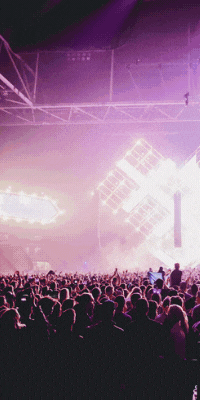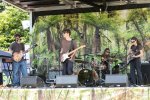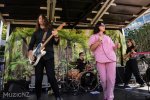Band & Musician News - Introducing Waiata/Anthems - NZ's Biggest Artists Performing Their Biggest Songs in Te Reo Maori

05 August 2019 - 0 Comments
Waiata/Anthems is released to celebrate Maori Language Week / Te Wiki o Te Reo Maori 2019 (Sep 9-15) and to coincide with the 20-year anniversary of Hinewehi Mohi first performing the New Zealand National Anthem in Te Reo Maori at an All Blacks game.
In 1999, singer and songwriter Hinewehi Mohi stood in front of 70,000 people at a sold-out Rugby World Cup quarter final in Twickenham and sang the words: “E Ihowā Atua…” All she had wanted to do when she chose to sing the national anthem in Te Reo Maori instead of English was share her language with the world.
Back home in New Zealand, the feedback was overwhelmingly negative and Mohi was forced to defend herself, and Te Reo Maori, in the media. This proved to be a turning point, sparking a national conversation about our cultural identity and the first language of Aotearoa New Zealand. Today, New Zealanders all over the country proudly sing the national anthem in both English and Te Reo Maori.
20 years on, she has decided to mark that anniversary not by remembering the controversy, but by celebrating how far we’ve come.
“At that time, talkback radio was the mouthpiece of the people, and there was a very loud voice saying ‘it’s not important to us, it doesn’t represent us’.”
“It was a difficult time, but I thought, rather than not talking about it – because it is important to talk about painful things sometimes – I would try to find a way to make the anniversary significant and use it as a platform to promote Te Reo Maori. Because it’s not about me. 20 years on we’re in a much better position because many, many hundreds of people have made a contribution to that shift in people’s thinking. Now we have queues of people trying to get into Maori language classes.”
The result – 11 of New Zealand’s best loved artists performing their hit songs in Te Reo Maori, as well as an acknowledgement of the events 20 years ago through a vibrant rendition of our National Anthem Aotearoa/God Defend New Zealand by the renowned Hatea Kapa Haka.
“It was initially meant to be a bilingual album, but the artists said to me ‘I want to do it all in Maori’. Only one is a fluent speaker, so for most of them this was their first real opportunity to sing in Māori. The artists have been brave and inspirational through the recording process which has ultimately been extremely challenging for the majority of them having little or no Maori language skills,” said Mohi. “It is testimony to how important they each view Te Reo Maori as the cornerstone of our culture. This music will help us all to feel like we can participate and celebrate in the uniqueness of our national identity.”
“These tracks are well known to people, so they can connect the English words they know to the Maori translation and feel like they’re accessing Te Reo Maori through something familiar.”
Recorded over 10 weeks in 2019, Mohi worked directly with artists in the studio to guide their intonation and understanding of the new Maori lyrics, with translations assisted by Sir Tīmoti Karetu, one of our greatest living Maori orators and language proponents. Mohi asked Sir Tīmoti because she knew his involvement would elevate the mana of the project and give the artists confidence in the words they were singing.
Bic Runga described the experience as “something I've always wanted to try but I was at a loss to know where to start. Having Hinewehi Mohi guide me through this process so generously has been really wonderful. I had to record the vocal well over 50 times to get it even close to right, but to finally sing in my own native tongue has been a really moving experience. The Maori language sings so beautifully, it's warm and percussive, and to have Sway translated by none other than Sir Timoti Karetu has been a huge honour. I've always written love songs, and somehow always felt a part of the tradition of the Māori love song, but without my language. So this is a little homecoming for Sway of sorts, it's been a really meaningful project to me.”
Even the original album artwork by rising artist Kauri Hawkins reinforces the message of empowering New Zealanders to learn and speak Te Reo Maori. The design represents the ‘manu’ or songbird and how we can use music to tell our stories and to share Te Reo Maori. The manu figure can also be seen as a face and its reference to our ‘native tongue’.
The theme for Maori Language Week this year is Kia Kaha Te Reo Maori, ‘Let’s make the Maori language strong’. Mohi acknowledges that each step we take, whether in learning or in embracing music in Te Reo Maori, makes the language stronger.
“Music knows no bounds, so it’s the perfect platform to express our unique heritage language and culture, within Aotearoa, and to the world.
“And it is something as New Zealanders, we can all be proud of, share and celebrate.”
TRACKLISTING OF WAIATA/ANTHEMS:
Hatea Kapa Haka - Aotearoa / God Defend New Zealand
Six60 - Kia Mau Ki To Ukaipo / Don’t Forget Your Roots
Stan Walker - Tena Ra Koe / Thank You
Benee - Kua Kore He Kupu / Soaked
Drax Project - I Moeroa / Woke Up Late
Shapeshifter - Nga Kano / In Colour
Kings - Kei Aro Atu Koe / Don’t Worry Bout’ It
Tiki Taane - Kei Toku Ngakau Nei Koe / Always On My Mind
Sons of Zion - Potere Ana / Drift Away
Bic Runga - Haere Mai Ra / Sway
Teeks - E Kore Rawa E Wehe / Never Be Apart
Tami Neilson - Roimata / Cry Myself To Sleep
Te Wiki o te Reo Maori hei te 9-15 o Mahuru 2019.
Maori Language Week runs from 9-15 September 2019.
Most Viewed Artists
Latest Galleries
NZ Top 10 Singles
- APT.
ROSÉ And Bruno Mars - DIE WITH A SMILE
Lady Gaga And Bruno Mars - BIRDS OF A FEATHER
Billie Eilish - TASTE
Sabrina Carpenter - I LOVE YOU, I'M SORRY
Gracie Abrams - ESPRESSO
Sabrina Carpenter - SAILOR SONG
Gigi Perez - LOSE CONTROL
Teddy Swims - A BAR SONG (TIPSY)
Shaboozey - GOOD LUCK, BABE!
Chappell Roan








 Report A Problem
Report A Problem


There are currently no comments for this article. Please log in to add new comments.